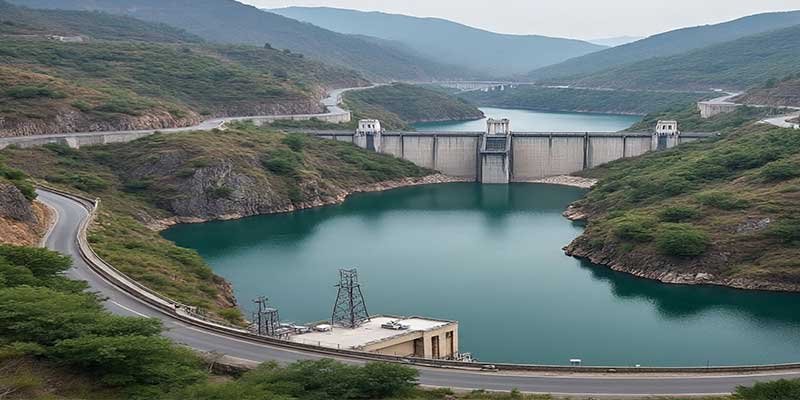India Accelerates Dibang Dam Construction in Arunachal Pradesh Amid Escalating Water Tensions with China
The Dibang project, spearheaded by state-owned NHPC Limited, aims to generate 2,880 MW of clean hydroelectric power annually .........

ITANAGAR- In a bold strategic maneuver, India has kicked off construction on what will become the world’s highest concrete gravity dam, the 278-meter Dibang Multipurpose Project in Arunachal Pradesh’s Lower Dibang Valley district.
The move, announced amid heightened geopolitical friction, is positioned as a direct counter to China’s ambitious mega-dam on the upstream Yarlung Tsangpo River in Tibet – a project that could reshape water flows across South Asia and raise the specter of a “Himalayan water war.”
The Dibang project, spearheaded by state-owned NHPC Limited, aims to generate 2,880 MW of clean hydroelectric power annually – enough to light up millions of homes in India’s Northern Grid – while doubling as a critical flood buffer.
Also Read- Multiple Landslides Disrupt Traffic and Prompt Travel Advisory
With a total investment of ₹31,875 crore (approximately $3.8 billion), the dam is expected to be operational by 2032, following a tight 91-month timeline outlined in the recent tender. Arunachal Pradesh will receive 12% of the generated power free of cost, plus an additional 1% earmarked for local development, injecting around ₹700 crore annually into the state’s economy.
Prime Minister Narendra Modi laid the foundation stone for the project last year, but work has gained unprecedented momentum in recent weeks.
Arunachal Pradesh Chief Minister Pema Khandu, along with Bharatiya Janata Party leaders, visited the site near Minli village to oversee progress, emphasizing its role in national security. “This isn’t just a hydro dam; its real objective is to save the Siang River and protect our people from upstream threats,” Khandu stated earlier this year, referencing fears of sudden water releases from Chinese infrastructure that could trigger devastating floods in downstream areas.
The Dibang River, a key tributary of the Brahmaputra, contributes about 7% to the mighty river’s annual runoff at Pandu in Assam. Experts hail the project as a multifaceted boon: bolstering energy security, moderating floods, and fostering regional development through thousands of jobs and improved infrastructure.
Yet, it arrives at a precarious moment, triggered by Beijing’s aggressive upstream ambitions. China’s Yarlung Tsangpo megaproject – dubbed the Motuo Hydropower Station – broke ground in July 2025 in the seismically volatile Yarlung Tsangpo Grand Canyon, the world’s deepest land canyon.
Costing an estimated 1.2 trillion yuan ($167 billion), this cascade of five hydropower stations is projected to produce 300 billion kWh of electricity yearly, tripling the output of the Three Gorges Dam and positioning it as the planet’s largest hydropower facility by 2033.
Also Read- PM Modi Inaugurates Assam Bioethanol Plant, Lays Foundation for Polypropylene Unit in Golaghat
The Yarlung Tsangpo flows southward from Tibet, entering Arunachal Pradesh as the Siang River before merging with the Dibang and Lohit to form the Brahmaputra – a lifeline for over 100 million people reliant on its waters for agriculture, fisheries, and drinking.
Critics warn that the dam could empower Beijing to divert flows, drastically reducing downstream volumes by up to 30% during dry seasons or unleash catastrophic floods via sudden releases – a potential “water bomb” in tense border regions.
Arunachal CM Pema Khandu has repeatedly cautioned that the Siang and Brahmaputra could “dry up considerably” post-completion, exacerbating vulnerabilities in flood-prone Assam and beyond.
The Dibang dam emerges as India’s riposte in this high-stakes hydrological chess game. By harnessing the river’s steep gradients for power while creating reservoirs to absorb potential surges, it aims to mitigate risks from the Yarlung Tsangpo behemoth.
Social media buzz reflects national pride, with users hailing it as a “game-changer for energy and security” and a symbol of India’s rising infrastructure prowess. Yet, the project isn’t without controversy. For over a decade, the Idu Mishmi tribe in Dibang Valley has protested, fearing displacement of thousands, loss of ancestral lands, and irreversible ecological damage to one of India’s most biodiverse regions.
Environmentalists highlight risks from seismic activity – a fresh 4.2-magnitude earthquake rattled nearby areas just yesterday – and question the long-term sustainability of mega-dams in fragile Himalayan ecosystems.
Protests earlier this year against related Siang Upper projects underscore local anxieties, with demonstrators decrying them as a “dam for a dam” mentality that prioritizes geopolitics over community rights.
As construction ramps up – with NHPC’s ₹17,069 crore global tender drawing international bids – the Dibang project underscores a broader Indo-Chinese rivalry over shared rivers. With no bilateral water-sharing agreement in place, experts urge diplomatic engagement to avert escalation. “Cooperation on the Yarlung Tsangpo-Brahmaputra is vital, especially amid climate change,” says Y. Nithiyanandam, a geospatial expert at Takshashila Institution. For now, India’s dam-building sprint signals resolve: in the shadow of the Himalayas, water is the new frontier of power.









